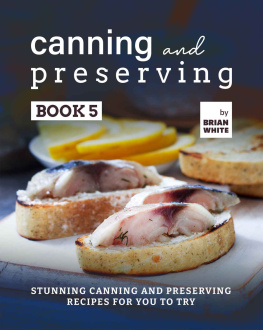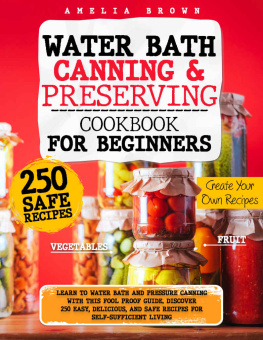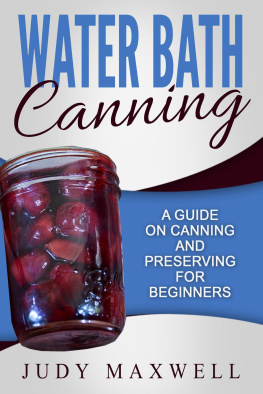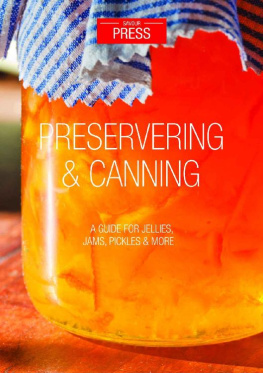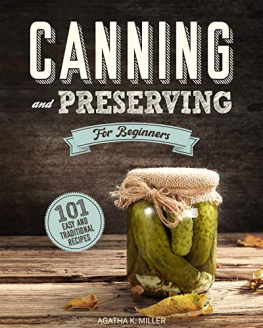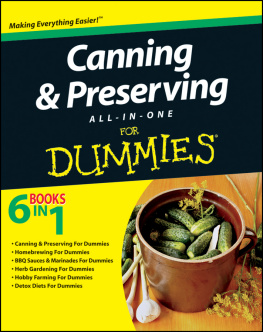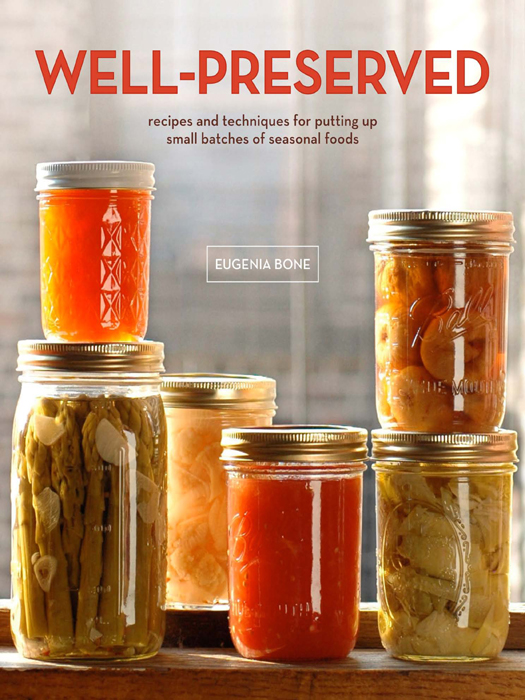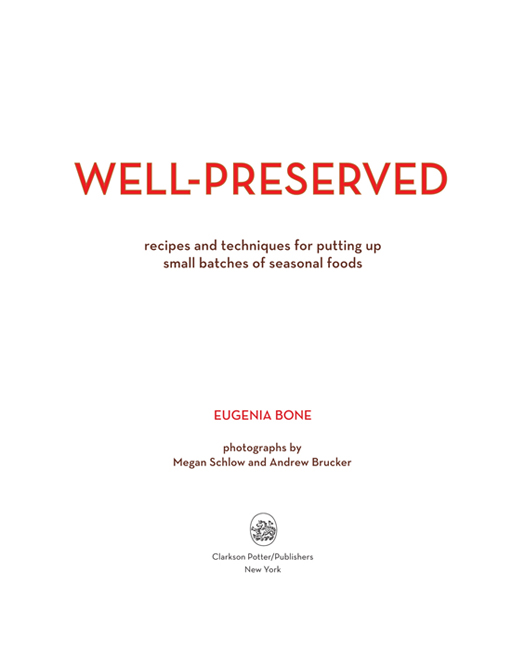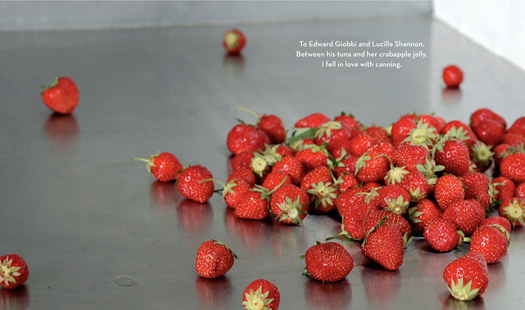All rights reserved.
Published in the United States by Clarkson Potter/
Publishers, an imprint of the Crown Publishing Group,
a division of Random House, Inc., New York.
www.crownpublishing.com
www.clarksonpotter.com
INTRODUCTION
I always walk to my local farmers market on Saturdays reciting the mantra I will not overbuy, I will not overbuy. As much as I love fresh fruits and vegetables, it makes me feel guilty to see them wrinkling and browning and bruising every time I open my fridge. But then Im at the market, and I smell the strawberries or notice the yellow zucchini blossoms, the tomatoes fragrant as flowers, and the sea scallops cold and fresh off the Brianna, the sweet corn a dozen ears for $3, and asparagus? I love them!
When my husband sees all the food I cart home, he inevitably gives me the You need to join a group look. But within a couple of days I manage to process all that glorious produce into jars and freezer bags, tucked away for future use, preserving the season in all its wonderful freshness and optimism. I want the bounty to go on forever, and in ways both literal and metaphorical, preserving is, for me, a tactic for capturing time.
Coming from an Italian household, home preserving was always a part of the ebb and flow of the seasons. My dad put up a wide variety of foodstuna in the late summer, tomatoes in the fall, prosciutto in the winter, as well as hot peppers stuffed with bread crumbs, pickled fava beans, olives, pesto, the must from pressed wine grapes, wild mushrooms. I enjoyed eating it all. But it is one thing to be the recipient of someone elses effort and quite another to do the work yourself. My dad lives in the country. He has a big kitchen, an even bigger garden, and woods teeming with wild things. I live in a rental in Manhattan and am powering through the supermom life, which means I have limited space and less time. Eventually, though, I learned you dont need a big country kitchen, or an orchard out back, to can with enthusiasm. Cities host excellent farmers markets, and Ive chosen the path of small-batch preserving, more inclined to variety than quantity. Ive also learned that I do indeed have the time to can, because by putting up small amounts of foods from which I can make subsequent meals, I expend less energy preparing dinner. I can accommodate unexpected guests with ease and flair. All it takes is an inspection of my freezer or my larderwhat the husband calls the bomb shelter.
Ironically, my interest in preserving didnt start at home: it was ignited during my second sophomore year of college. I lived in a ratty railroad flat above Mamoons Falafel on Bleecker Street in New York City. Probably as an act of charity (I was living on peanut butter and falafel), a friend of my parents, the restaurant critic Jay Jacobs, used to take me to lunch when he was reviewing. We eventually became good friends in our own right, and Jay invited me to brunch at his Upper East Side apartment. All kinds of sophisticates were there, and me, a fairly unpolished twenty-year-old in a plastic miniskirt. I was dazzlednot by the muckety-mucks sipping Corton Charlemagne and trading stock tips, but by the buffet: soft scrambled eggs, golden brioche as puffy as cumulus clouds, and a curling pile of thinly sliced gravlax, coral colored and opalescent, that was utterly light and creamy. I was smitten. Jay told me hed made the gravlax a couple days before, that a monkey could make it and I was welcome to the recipe.
That such a marvelous dish could be made at home and stored in my wheezing old refrigerator was a miracle to me. I went back to my apartment, Jays twenty-something son in tow, where we smoked a joint. While I rhapsodized about cured fish, imagining my own brilliant brunches, he swooned and fell off the edge of my platform bed. That and other distractions ensured it would be another six years before I actually made the recipe.
My canning fixation came into full flower when I was eight months pregnant with my second child, Mo. I had gone into the nesting stage. For some women that means buying burp cloths or stenciling borders on the nursery wall, but for me it was an obsession with preserving. Somehow I just got it into my head that with two small children Id be housebound for months and we would all likely starve. When I told my father that I wanted to can, it was like encountering a fellow smoker on the sidewalkhe was my co-conspiratorand we put up twenty pints of tomatoes that first year. My fears of domestic incarceration passed soon after my son was born, but the pleasure of having those tomatoes in the cupboard stuck with me.
Over the course of the next few years Dad also taught me how to preserve in oil, how to pickle, and how to cure, but I think my most cherished canning recipe from him was pressure-canned tuna fish. We used to summer in Provincetown, Massachusetts, when I was a kid, and every August Dad would go to the docks pulling a childs red wagon and roll home a tremendous two-hundred-pound tuna that hed bought off the pier and gutted there, chucking the chum into the bay among screeching gulls. Dad flopped the big silver fish, round as a barrel, into the only bathtub in the house, where he salted it and soaked it in cold running water. For two days the fish bled in the tub. It was fascinating, but in my self-conscious pubescence I found it intimidating to use the toilet with that big fish so close, its round eye staring glassily at the showerhead.
When the tuna was clean, Dad cleared off the dinner table and butchered the meat. The best partthe fatty belly meatwe ate fresh; the rest he shoved into half-pint jars, covered in oil, and pressure-canned. Cases of pink meat glistened in jars, aging under the couches, until we went home to New York. It seemed an impossible feat, the work of a titan canner. And then, about five years ago, my buddy Beaver (his real moniker: all the Truax boys were named after small mammals) got a connection to a fisherman in Montauk who delivered the goods: twenty pounds of yellowtail caught just twenty-four hours earlier. After numerous conference calls with my father, we canned it up. Ive been canning tuna ever since, albeit smaller amounts of fish I buy retail. I kind of miss the tuna in the tub, but every fall I preserve the memory in a jar.



